Vesta
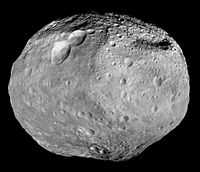
In the full image of Vesta at right, the rocky-object appears to have suffered from meteor damage.
Astronomy
- diameter= 530 kilometres
- features= Veneneia basin
Planetary science
Def. an "astronomical object in direct orbit around the Sun [or another star] smaller than a planet and not classified as a comet.[1]"[2] is called a minor planet.
Def.
- an "asteroid of any size"[3],
- an "asteroid-like body in an orbit beyond the asteroid belt"[3],
- a "larger, planetary, body in orbit around the Sun"[3], or other star, or
- a "dwarf planet"[3],
is called a planetoid.
Usage notes: "The term "planetoid" has never been precisely defined. At first, it was a synonym for asteroid; whereas "asteroid" referred to the star-like image seen through a telescope, "planetoid" referred to its planet-like orbit. Though it approached the popularity of "asteroid" ca. 1915, this usage was never dominant, and largely ceased by ca. 1980. Even before then the etymology of the term was reanalyzed as meaning planet-like in form, and started being used for larger asteroids such as Vesta which had planet-like geologies (that is, were planetary bodies). There was an increase in such usage after 2000 with the discovery of planetary bodies in the Kuiper belt and beyond, which many felt were not appropriately called "asteroids" and concomitant with doubts as to the appropriate definition of "planet". Sedna, for example, was called a "planetoid" in its discovery announcement."
"The group of small bodies that circle round the Sun, outside the orbit of Mars, are known under the designation of the planetoids."[4] Bold added.
For a model on the generation of chondrites, "if one can argue for the early existence of a few largely molten planetoids with dimension of kilometers or tens of kilometers, one can quite as easily argue for very large numbers of such planetoids."[5]
Def. any "of many small, solid astronomical objects, that orbit a star and form protoplanets through mutual gravitational attraction"[6] is called a planetesimal.
Minerals
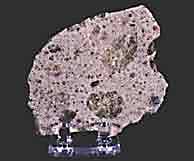
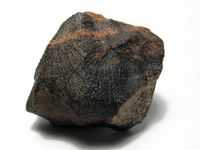
Def. an "achondritic stony meteorite originating from deep within the crust of the asteroid 4 Vesta"[7] is called a diogenite.
Def. an "achondritic meteoritic rock consisting chiefly of pigeonite and anorthite"[8] is called a eucrite.
The eucrite specimen at left is approximately 6 cm wide. Note the shiny black fusion crust with flow lines. The chip at lower right allows one to see the light-gray interior. The orange staining at top is a result of weathering, as these stones were not recovered until many years after they fell.
Def. an "achondritic stony meteorite"[9] is called a howardite.
Theory of Vesta
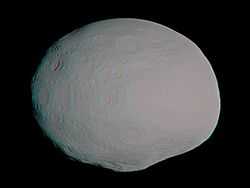
Vesta may have been melted 4.5 mya and it is believed to once have volcanic activity.[10] Smaller asteroids may have deposited carbon material to Vesta, contrasting its bright color.[10]
Vesta doesn't have enough gravity to form it into a complete sphere, which is why it is not a dwarf planet.
This anaglyph [of Vesta at right] -- best viewed through red-blue glasses -- shows a 3-D model of the protoplanet Vesta, using scientists' best guess to date of what the surface of the protoplanet might look like. It was created as part of an exercise for NASA's Dawn mission involving mission planners at NASA's Jet Propulsion Laboratory and science team members at the Planetary Science Institute in Tuscon, Ariz.
The images incorporate the best data on dimples and bulges of the protoplanet Vesta from ground-based telescopes and NASA's Hubble Space Telescope. The cratering and small-scale surface variations are computer-generated, based on the patterns seen on the Earth's moon, an inner solar system object with a surface appearance that may be similar to Vesta.
Vesta, located in the main asteroid belt between Mars and Jupiter, formed very early in the history of the solar system and has one of the oldest surfaces in the system. Scientists are eager to get their first close-up look so they can better understand this early chapter.
Meteors
"It lost some 1% of its mass less than a billion years ago in a collision that left an enormous crater occupying much of its southern hemisphere. Debris from this event has fallen to Earth as howardite–eucrite–diogenite (HED) meteorites, a rich source of information about the asteroid.[11][12]"[13]
Neutrons
"Using Dawn’s Gamma Ray and Neutron Detector, ... Global Fe/O and Fe/Si ratios are consistent with [howardite, eucrite, and diogenite] HED [meteorite] compositions."[14]
Opticals
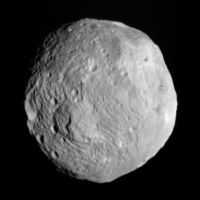
"NASA's Dawn spacecraft obtained [the] image [at right] with its framing camera on July 9, 2011. It was taken from a distance of about 26,000 miles (41,000 kilometers) away from the protoplanet Vesta. Each pixel in the image corresponds to roughly 2.4 miles (3.8 kilometers)."[15]
Visuals
"The angular resolution of the naked eye is about 1′; however, some people have sharper vision than that. There is anecdotal evidence that people had seen the Galilean moons of Jupiter before telescopes were invented.[16] Of similar magnitude, Uranus and Vesta had most probably been seen but could not be recognized as planets because they appear so faint even at maximum brightness that their motion could not be detected.”[17]
Oranges
"The [NASA's Dawn spacecraft] Framing Camera (FC) discovered enigmatic orange material on Vesta. FC images revealed diffuse orange ejecta around two impact craters, 34-km diameter Oppis, and 30-km diameter Octavia, as well as numerous sharp-edge orange units in the equatorial region."[18] The spacecraft "entered orbit around asteroid (4) Vesta in July 2011 for a year-long mapping orbit."[18]
Reds
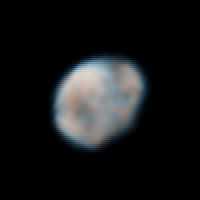
"To prepare for the Dawn spacecraft's visit to Vesta, astronomers used Hubble's Wide Field Planetary Camera 2 to snap new images of the asteroid. The image at right was taken on May 14 and 16, 2007. Using Hubble, astronomers mapped Vesta's southern hemisphere, a region dominated by a giant impact crater formed by a collision billions of years ago. The crater is 285 miles (456 kilometers) across, which is nearly equal to Vesta's 330-mile (530-kilometer) diameter. If Earth had a crater of proportional size, it would fill the Pacific Ocean basin. The impact broke off chunks of rock, producing more than 50 smaller asteroids that astronomers have nicknamed "vestoids." The collision also may have blasted through Vesta's crust. Vesta is about the size of Arizona."[19]
"Previous Hubble images of Vesta's southern hemisphere were taken in 1994 and 1996 with the wide-field camera. In this new set of images, Hubble's sharp "eye" can see features as small as about 37 miles (60 kilometers) across. The image shows the difference in brightness and color on the asteroid's surface. These characteristics hint at the large-scale features that the Dawn spacecraft [sees] when it arrives at Vesta."[19]
"Hubble's view reveals extensive global features stretching longitudinally from the northern hemisphere to the southern hemisphere. The image also shows widespread differences in brightness in the east and west, which probably reflects compositional changes. Both of these characteristics could reveal volcanic activity throughout Vesta. The size of these different regions varies. Some are hundreds of miles across."[19]
"The brightness differences could be similar to the effect seen on the Moon, where smooth, dark regions are more iron-rich than the brighter highlands that contain minerals richer in calcium and aluminum. When Vesta was forming 4.5 billion years ago, it was heated to the melting temperatures of rock. This heating allowed heavier material to sink to Vesta's center and lighter minerals to rise to the surface."[19]
"Astronomers combined images of Vesta in two colors to study the variations in iron-bearing minerals. From these minerals, they hope to learn more about Vesta's surface structure and composition."[19]
"The simplest model for the genesis of the HED meteorites involves a series of partial melting and crystallization events [1] of a small parent body whose bulk composition is more or less consistent with cosmic abundances but is depleted in the moderately volatile elements Na and K [2]."[20]
"Why should both Vesta and the Moon be rich in oxidized Fe but depleted in Na and K?"[20]
"How did the HEDs get here from Vesta? The discovery of a string of Vesta-like asteroids in orbits linking Vesta to nearby orbital resonances [5] has shown that [...] arguments [...] for material originating at Vesta to reach Earth-crossing orbits are [...] valid."[20]
"An alternative theory is based on electromagnetic heating during an episode of strong solar wind from the early proto-Sun when our star experienced a T Tauri phase, as predicted by modern stellar astrophysics."[21]
Meteorites
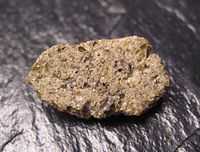
"An achondrite ... is a stony meteorite that does not contain chondrules. It consists of material similar to terrestrial basalts or plutonic rocks and has been differentiated and reprocessed to a lesser or greater degree due to melting and recrystallization on or within meteorite parent bodies.[22][23] As a result, achondrites have distinct textures and mineralogies indicative of igneous processes.[24]"[25]
"Achondrites account for about 8% of meteorites overall, and the majority (about two thirds) of them are HED meteorites, originating from the crust of asteroid 4 Vesta. Other types include Martian, Lunar, and several types thought to originate from as-yet unidentified asteroids other than Vesta. These groups have been determined on the basis of e.g. the Fe/Mn chemical ratio and the 17O/18O oxygen isotope ratios, thought to be characteristic "fingerprints" for each parent body.[26]"[25]
"Debris from [a meteor collison with Vesta] has fallen to Earth as howardite–eucrite–diogenite (HED) meteorites, a rich source of information about the asteroid.[11][12]"[13]
Micrometeorite is often abbreviated as MM. Most MMs are broadly chondritic in composition, meaning "that major elemental abundance ratios are within about 50% of those observed in carbonaceous chondrites."[27] Some MMs are chondrites, (basaltic) howardite, eucrite, and diogenite (HED) meteorites or Martian basalts, but not lunar samples.[27] "[T]he comparative mechanical weakness of carbonaceous precursor materials tends to encourage spherule formation."[27] From the number of different asteroidal precursors, the approximate fraction in MMs is 70 % carbonaceous.[27] "[T]he carbonaceous material [is] known from observation to dominate the terrestrial MM flux."[27] The "H, L, and E chondritic compositions" are "dominant among meteorites but rare among micrometeorites."[27]
"Ureilites occur about half as often as eucrites (Krot et al. 2003), are relatively friable, have less a wide range of cosmic-ray exposure ages including two less than 1 Myr, and, like the dominant group of MM precursors, contain carbon."[27]
Asteroids
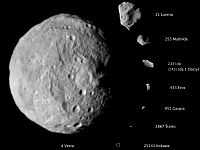
"Vesta, minor-planet designation 4 Vesta, is one of the largest asteroids in the Solar System".[13]
Technology

"The Visible and IR spectrometer is able to make pictures of the core in the IR and also search for IR spectra of molecules in the coma. The detection is done by a mercury cadmium teluride array for IR and with a CCD chip for the Visible range. ... improved versions were used for Dawn and Venus express.[28]"[29]
The Dawn spacecraft has onboard a framing camera (FC) with a refractive optical system and an 8-position filter wheel of a panchromatic (clear filter) and seven narrow band filters.[30] "The visual and infrared spectrometer (VIR) ... [has] an array of HgCdTe photodiodes cooled to about 70K spans the spectrum from 0.95 to 5.0 µm.[31][32]"[30] The green filter aboard Dawn in the FC has a central wavelength of 555 nm.[33] The VIR on Dawn has a green filter centered at 563 nm.[15]
Research
Hypothesis:
- If most of the asteroids in the asteroid belt are spheroidal, then the belt is much older than it appears.
Control groups

The findings demonstrate a statistically systematic change from the status quo or the control group.
“In the design of experiments, treatments [or special properties or characteristics] are applied to [or observed in] experimental units in the treatment group(s).[34] In comparative experiments, members of the complementary group, the control group, receive either no treatment or a standard treatment.[35]"[36]
Proof of concept
Def. a “short and/or incomplete realization of a certain method or idea to demonstrate its feasibility"[37] is called a proof of concept.
Def. evidence that demonstrates that a concept is possible is called proof of concept.
The proof-of-concept structure consists of
- background,
- procedures,
- findings, and
- interpretation.[38]
See also
References
- ↑ "Minor planet" (HTML). Wikipedia. 2013-06-03. Archived from the original on 2013-06-03. Retrieved 2013-06-08.
- ↑ "minor planet, In: Wiktionary". San Francisco, California: Wikimedia Foundation, Inc. August 29, 2013. Retrieved 2013-08-30.
- 1 2 3 4 "planetoid, In: Wiktionary". San Francisco, California: Wikimedia Foundation, Inc. June 18, 2013. Retrieved 2013-08-30.
- ↑ Robert James Mann (1856). A guide to astronomical science. p. 231.
- ↑ H.A. Zook (1979). "On a New Model for the Generation of Chondrites". Lunar and Planetary Science 12: 1242.
- ↑ "planetesimal, In: Wiktionary". San Francisco, California: Wikimedia Foundation, Inc. June 18, 2013. Retrieved 2013-08-30.
- ↑ "diogenite, In: Wiktionary". San Francisco, California: Wikimedia Foundation, Inc. December 5, 2008. Retrieved 2013-12-20.
- ↑ "eucrite, In: Wiktionary". San Francisco, California: Wikimedia Foundation, Inc. June 20, 2013. Retrieved 2013-12-20.
- ↑ "howardite, In: Wiktionary". San Francisco, California: Wikimedia Foundation, Inc. June 20, 2013. Retrieved 2013-12-20.
- 1 2 "Carbon in Vesta's craters". Max-Planck-Gesellschaft. 2013.
- 1 2 Kelley, M. S.; et al. (2003). "Quantified mineralogical evidence for a common origin of 1929 Kollaa with 4 Vesta and the HED meteorites". Icarus 165 (1): 215. doi:10.1016/S0019-1035(03)00149-0.
- 1 2 "Vesta". NASA/JPL. 12 July 2011. Archived from the original on 29 June 2011. Retrieved 30 July 2011.
- 1 2 3 "4 Vesta, In: Wikipedia". San Francisco, California: Wikimedia Foundation, Inc. April 12, 2013. Retrieved 2013-04-13.
- ↑ Thomas H. Prettyman, David W. Mittlefehidt, Naoyuki Yamashita, David J. Lawrence, Andrew W. Beck, William C. Feldman, Timothy J. McCoy, Harry Y. McSween, Michael J. Toplis, Timothy N. Titus, Pasquale Tricarico, Robert C. Reedy, John S. Hendricks, Olivier Forni, Lucille Le Corre, Jian-Yang Li, Hugau Mizzon, Vishnu Reddy, Carol A. Raymond, Christopher T. Russell (October 2012). "Elemental Mapping by Dawn Reveals Exogenic H in Vesta's Regolith". Sience 338 (6104): 242-6. doi:10.1126/science.1225354.
- 1 2 Joe Wise (July 14, 2011). "Image of Vesta Captured by Dawn on July 9, 2011". JPL, Pasadena, California USA: NASA. Retrieved 2013-12-20.
- ↑ Zezong, Xi, "The Discovery of Jupiter's Satellite Made by Gan De 2000 years Before Galileo", Chinese Physics 2 (3) (1982): 664–67.
- ↑ "Naked eye in astronomy, In: Wikipedia". San Francisco, California: Wikimedia Foundation, Inc. June 3, 2012. Retrieved 2012-06-09.
- 1 2 L Le Corre, V Reddy, KJ Becker (October 2012). "Nature of Orange Ejecta Around Oppia and Octavia Craters on Vesta from Dawn Framing Camera". American Astronomical Society, DPS meeting (44).
- 1 2 3 4 5 Ray Villard and Lucy McFadden (June 20, 2007). "Hubble Images of Asteroids Help Astronomers Prepare for Spacecraft Visit". Space Telescope Science Institute, Baltimore, Md USA: HubbleSite. Retrieved 2013-12-22.
- 1 2 3 G. J. Consolmagno (January 1996). "Cosmogonic Implications of the HED-Vesta Connection". Workshop on Evolution of Igneous Asteroids: Focus on Vesta and the HED Meteorites: 6. http://adsabs.harvard.edu/abs/1996eiaf.conf....6C. Retrieved 2013-12-22.
- ↑ L. Bussolino, R. Sommat, C. Casaccit, V. Zappala, A. Cellino, and M. Di Martino (January 1996). "A Space Mission to Vesta: General Considerations". Workshop on Evolution of Igneous Asteroids: Focus on Vesta and the HED Meterorites (http://adsabs.harvard.edu/abs/1996eiaf.conf....5B): 5.
- ↑ Sahijpal, S.; Soni, P.;Gagan, G. (2007). "Numerical simulations of the differentiation of accreting planetesimals with 26Al and 60Fe as the heat sources". Meteoritics & Planetary Science 42 (9): 1529–1548. doi:10.1111/j.1945-5100.2007.tb00589.x.
- ↑ Gupta, G.; Sahijpal, S. (2010). "Differentiation of Vesta and the parent bodies of other achondrites". J. Geophys. Res. (Planets) 115. doi:10.1029/2009JE003525.
- ↑ Brian Mason (1962). Meteorites. New York: John Wiley.
- 1 2 "Achondrite, In: Wikipedia". San Francisco, California: Wikimedia Foundation, Inc. August 18, 2012. Retrieved 2012-10-13.
- ↑ David W. Mittlefehldt, Timothy J. McCoy, Cyrena Anne Goodrich, and Alfred Kracher (1998). "Non-chondritic Meteorites from Asteroidal Bodies". Reviews in Mineralogy and Geochemistry 36 (1): 4.1–4.195. http://rimg.geoscienceworld.org/cgi/content/abstract/36/1/4.1.
- 1 2 3 4 5 6 7 Susan Taylor, Gregory F. Herzog, Gregory, Jeremy S. Delaney, (2007). "Crumbs from the crust of Vesta: Achondritic cosmic spherules from the South Pole water well". Meteoritics & Planetary Science 42 (2): 223-33. doi:10.1111/j.1945-5100.2007.tb00229.x.
- ↑ Coradini, A.; Capaccioni, F.; Capria, M. T.; Cerroni, P.; de Sanctis, M. C.; Magni, G.; Reininger, F.; Drossart, P.; Barucci, M. A.; Bockelee-Morvan, D.; Combes, M.; Crovisier, J.; Encrenaz, T.; Tiphene, D.; Arnold, G.; Carsenty, U.; Michaelis, H.; Mottola, S.; Neukum, G.; Schade, U.; Taylor, F.; Calcutt, S.; Vellacott, T.; Venters, P.; Watkins, R. E.; Bellucci, G.; Formisano, V.; Angrilli, F.; Bianchini, G.; Saggin, B.; Bussoletti, E.; Colangeli, L.; Mennella, V.; Fonti, S.; Tozzi, G.; Bibring, J. P.; Langevin, Y.; Schmitt, B.; Combi, M.; Fink, U.; McCord, T.; Ip, W.; Carlson, R. W.; Jennings, D. E.. "VIRTIS Visible Infrared Thermal Imaging Spectrometer for Rosetta Mission". Lunar and Planetary Science 27: 253.
- ↑ "Rosetta (spacecraft), In: Wikipedia". San Francisco, California: Wikimedia Foundation, Inc. January 17, 2013. Retrieved 2013-01-26.
- 1 2 "Dawn (spacecraft), In: Wikipedia". San Francisco, California: Wikimedia Foundation, Inc. January 6, 2013. Retrieved 2013-01-26.
- ↑ Rayman, Marc; Fraschetti, Raymond, Russell (5). "Dawn: A mission in development for exploration of main belt asteroids Vesta and Ceres". Acta Astronautica 58 (11): 605–16. doi:10.1016/j.actaastro.2006.01.014. http://dawn.jpl.nasa.gov/mission/Dawn_overview.pdf. Retrieved 14 April 2011.
- ↑ Sanctis, M. C.; Coradini, A.; Ammannito, E.; Filacchione, G.; Capria, M. T.; Fonte, S.; Magni, G.; Barbis, A. et al. (2010). "The VIR Spectrometer". Space Science Reviews. doi:10.1007/s11214-010-9668-5.
- ↑ B. W. Denevi, E. I. Coman, U. Carsenty, D. T. Blewett, D. W. Mittlefehldt, D. L. Buczkowski, J.-P. Combe, M. T. Capria, M. C. De Sanctis, R. Jaumann, J-Y. Li, S. Marchi, A. Nathues, N. E. Petro, C. M. Pieters, P. Schenk, N. Schmedemann, S. Schröder, J. M. Sunshine, M. Toplis, D. A. Williams, C. A. Raymond, and C. T. Russell (August 13, 2012). "Global Variations in Regolith Depth on Asteroid Vesta". European Planetary Science Congress Abstracts 7: 2. http://meetingorganizer.copernicus.org/EPSC2012/EPSC2012-813.pdf. Retrieved 2013-01-26.
- ↑ Klaus Hinkelmann, Oscar Kempthorne (2008). Design and Analysis of Experiments, Volume I: Introduction to Experimental Design (2nd ed.). Wiley. ISBN 978-0-471-72756-9. http://books.google.com/?id=T3wWj2kVYZgC&printsec=frontcover.
- ↑ R. A. Bailey (2008). Design of comparative experiments. Cambridge University Press. ISBN 978-0-521-68357-9. http://www.cambridge.org/uk/catalogue/catalogue.asp?isbn=9780521683579.
- ↑ "Treatment and control groups, In: Wikipedia". San Francisco, California: Wikimedia Foundation, Inc. May 18, 2012. Retrieved 2012-05-31.
- ↑ "proof of concept, In: Wiktionary". San Francisco, California: Wikimedia Foundation, Inc. November 10, 2012. Retrieved 2013-01-13.
- ↑ Ginger Lehrman and Ian B Hogue, Sarah Palmer, Cheryl Jennings, Celsa A Spina, Ann Wiegand, Alan L Landay, Robert W Coombs, Douglas D Richman, John W Mellors, John M Coffin, Ronald J Bosch, David M Margolis (August 13, 2005). "Depletion of latent HIV-1 infection in vivo: a proof-of-concept study". Lancet 366 (9485): 549-55. doi:10.1016/S0140-6736(05)67098-5. http://www.ncbi.nlm.nih.gov/pmc/articles/PMC1894952/. Retrieved 2012-05-09.
Further reading
- Susan Taylor, Gregory F. Herzog, Gregory, Jeremy S. Delaney, (2007). "Crumbs from the crust of Vesta: Achondritic cosmic spherules from the South Pole water well". Meteoritics & Planetary Science 42 (2): 223-33. doi:10.1111/j.1945-5100.2007.tb00229.x.
External links
- African Journals Online
- Bing Advanced search
- Google Books
- Google scholar Advanced Scholar Search
- International Astronomical Union
- JSTOR
- Lycos search
- NASA/IPAC Extragalactic Database - NED
- NASA's National Space Science Data Center
- NCBI All Databases Search
- Office of Scientific & Technical Information
- PubChem Public Chemical Database
- Questia - The Online Library of Books and Journals
- SAGE journals online
- The SAO/NASA Astrophysics Data System
- Scirus for scientific information only advanced search
- Spacecraft Query at NASA.
- SpringerLink
- Taylor & Francis Online
- Universal coordinate converter
- Wiley Online Library Advanced Search
- Yahoo Advanced Web Search
| ||||||||||||||||||||||||||||||||
| |||||||||||||||||||||||||||||||||||
| |||||||||||||||||||||||||||||||||||
![]() This is a research project at http://en.wikiversity.org
This is a research project at http://en.wikiversity.org
| |
Development status: this resource is experimental in nature. |
| |
Educational level: this is a research resource. |
| |
Resource type: this resource is an article. |
| |
Resource type: this resource contains a lecture or lecture notes. |
| |
Subject classification: this is an astronomy resource. |
| |
Subject classification: this is a Geology resource. |